Highlights
- HyperOS introduces customisable lock screens, AI gallery features, and efficiency improvements.
- Over 26 Xiaomi devices in India, including Xiaomi 13 Pro and Mi 10, slated for HyperOS update.
- Redmi Note 13 series among devices receiving HyperOS in Q2 2024.
- Xiaomi 14, featuring Snapdragon 8 Gen 3 and Leica camera, to launch with HyperOS.
Xiaomi has just unveiled an exciting update for its legion of fans in India at the recent A Human X Car X Home Ecosystem event held on Thursday.
The tech giant shared a comprehensive list of devices set to receive the much-anticipated HyperOS update.
The Future is Now with HyperOS
Here’s the latest rollout plan for #XiaomiHyperOS India.
Keep an eye out for your device and follow us to get the latest news of rollout schedule.#XiaomiHyperOSRolloutPlan pic.twitter.com/cLu3CEQ3hm— Xiaomi India (@XiaomiIndia) February 29, 2024
Xiaomi says that HyperOS isn’t just a mere update; it’s a transformative overhaul designed to bring a suite of innovative features to Xiaomi devices.
Key highlights include a customisable lock screen, advanced AI functionalities within the gallery app, and a more efficient operating system that aims to occupy less storage space.
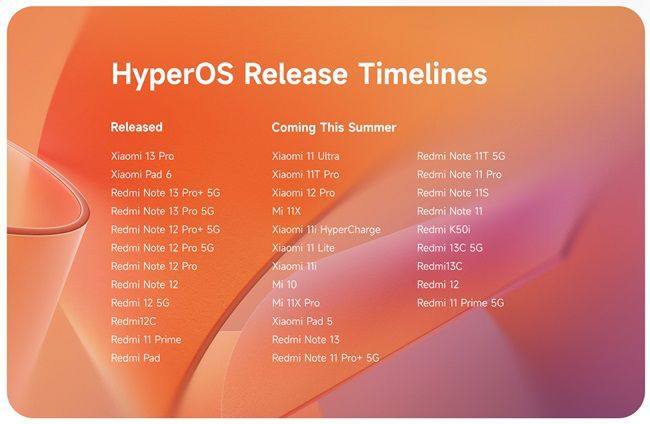
This shift towards HyperOS marks a significant leap forward in Xiaomi’s software evolution, showcasing its dedication to enhancing user experience and device performance.
Extensive Support Across the Board
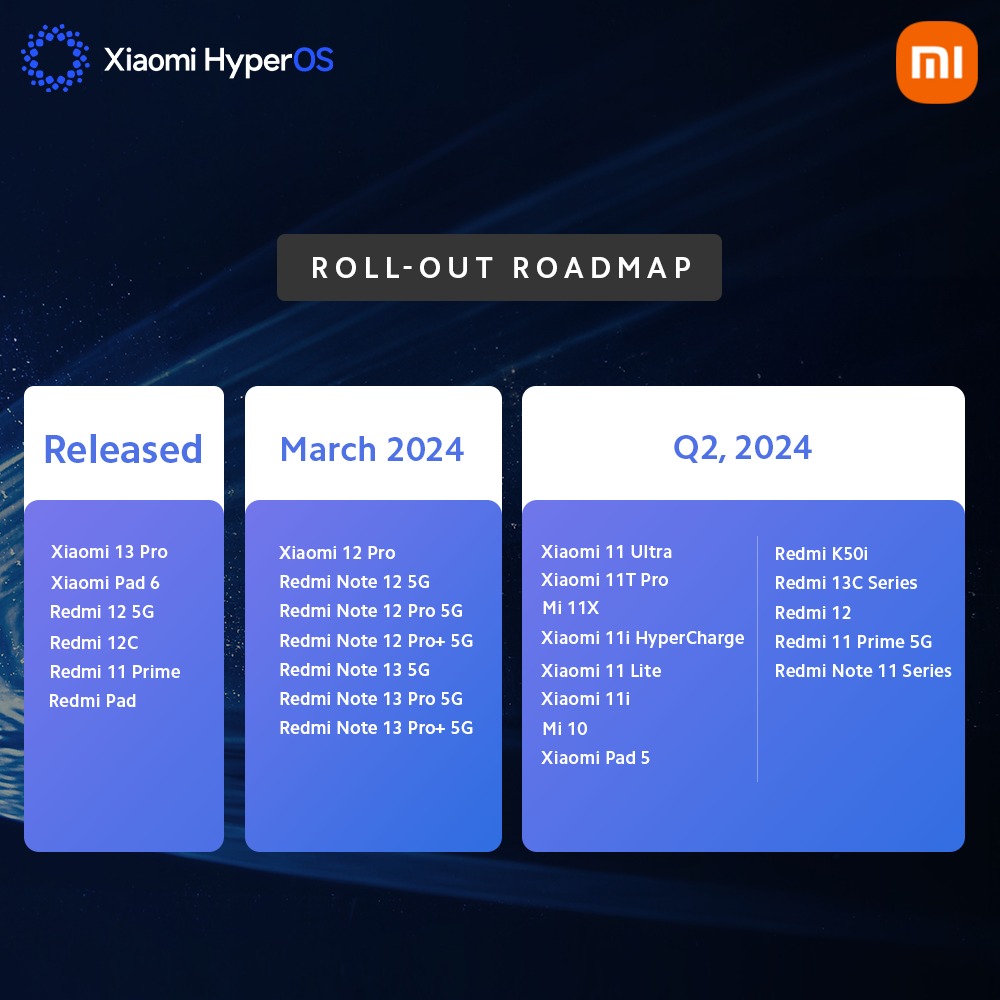
Xiaomi’s rollout plan for HyperOS is extensive, covering over 26 devices in the Indian market.
This list includes both newer models, such as the Xiaomi 13 Pro and the Xiaomi Pad 6, and older favorites like the Xiaomi 11 Ultra and the Mi 10.
Notably, the update encompasses a range of devices launched in March, including the Redmi Note 13 5G, Redmi Note 13 Pro 5G, and Redmi Note 13 Pro+ 5G, alongside other popular models such as the Xiaomi 12 Pro, Redmi Note 12 series, Mi 11X, and Xiaomi Pad 5.
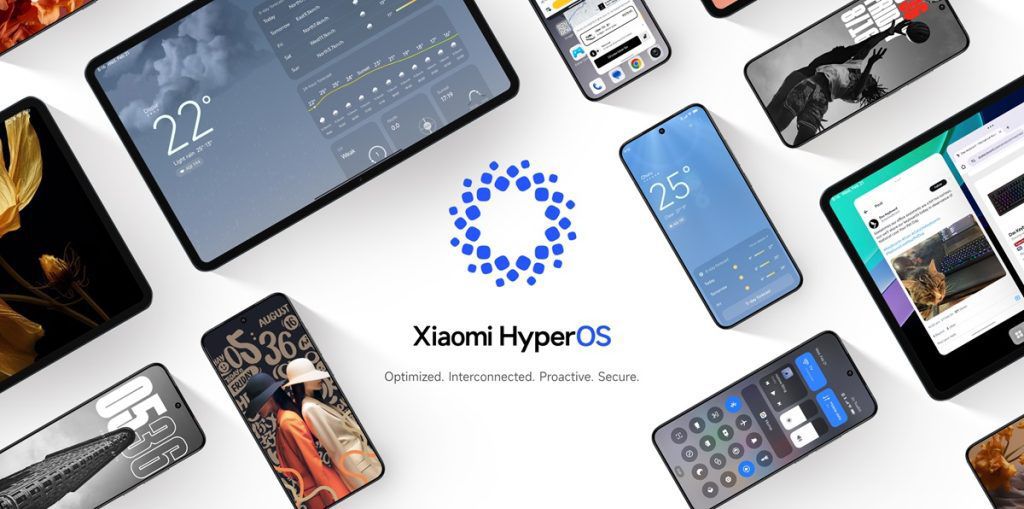
These devices, along with the Redmi Note 11 series and more, are slated to receive the HyperOS update in the second quarter of 2024.
While Xiaomi has a history of supporting its devices with MIUI updates, the transition to HyperOS raises questions about the base Android version for older models.

It remains to be seen whether these updates will leverage Android 14, similar to the latest devices.
This ambiguity aside, the move to HyperOS is a clear signal of Xiaomi’s forward-thinking approach and its relentless pursuit of innovation.
Xiaomi 14’s India Launch on the Horizon

Amidst this wave of updates, Xiaomi is also gearing up to launch its flagship device, the Xiaomi 14, on March 7.
Powered by the cutting-edge Snapdragon 8 Gen 3 and equipped with a Leica camera, the Xiaomi 14 is set to make a grand entrance with HyperOS pre-installed.
The device will be a flagship offering from Xiaomi and will be priced following its specs, which is today at least above Rs 60,000. Rest we shall know on the day of the launch.
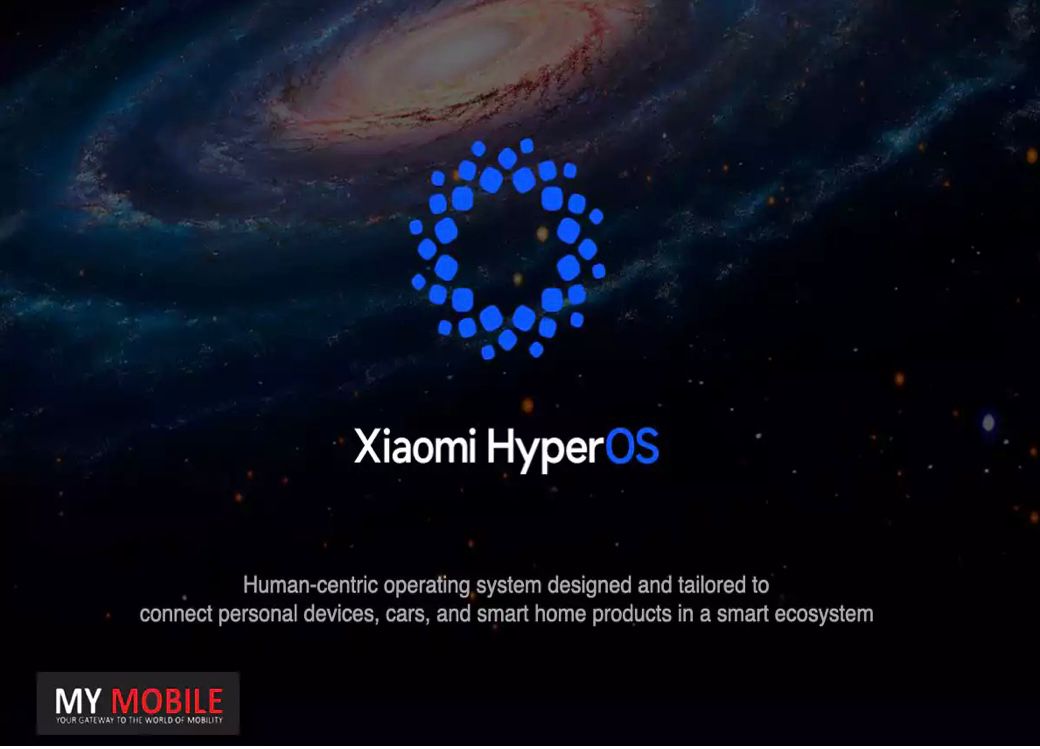
A Leap for Mobile operating systems
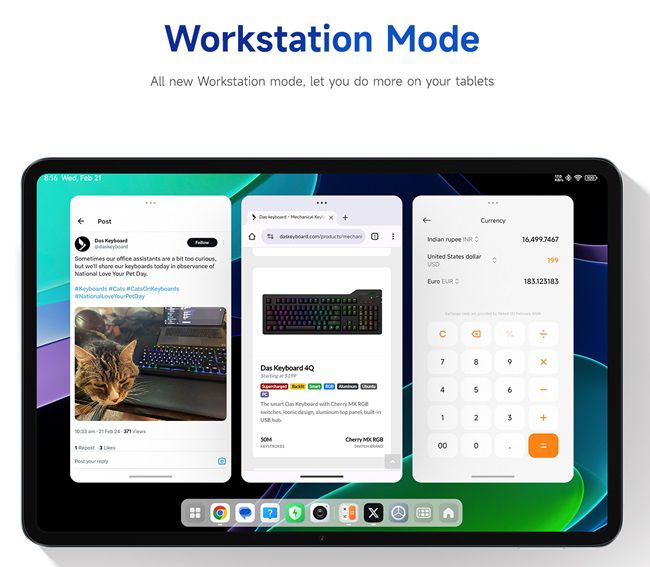
15 years ago, the tech landscape saw a pivotal shift from basic feature phones to smartphones, powered by emerging operating systems.
Fast forward to 2024, with an estimated 7.1 billion smartphone users globally, and a new inflection point in consumer technology has now emerged.
With 600 million+ smart devices worldwide, Xiaomi is the largest connected smart device brand today.
With this in mind, Xiaomi HyperOS has been designed for consumers who are now increasingly asking for interoperability and seamless interconnectivity between their different personal devices.
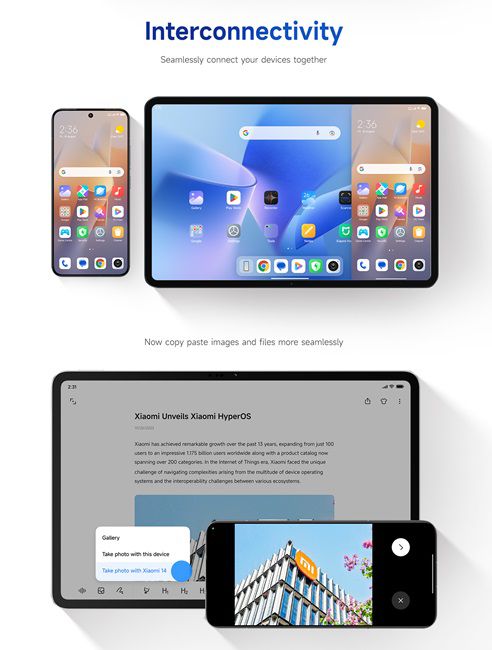
The current fragmented OS landscape was never designed for the complexities of modern connected ecosystems.
For Xiaomi, with its diverse ecosystem of products, the challenge was even more unique with each device utilizing different connectivity mechanisms.
Due to limited interoperability with products from other companies, there were also issues arising with Wi-Fi and Bluetooth compatibility.
A culmination of extensive research and development, Xiaomi HyperOS has been developed to set a new benchmark in the technology industry, which will redefine how users interact with their devices, providing a more intuitive, secure and enjoyable experience.
Latest features of HyperOS
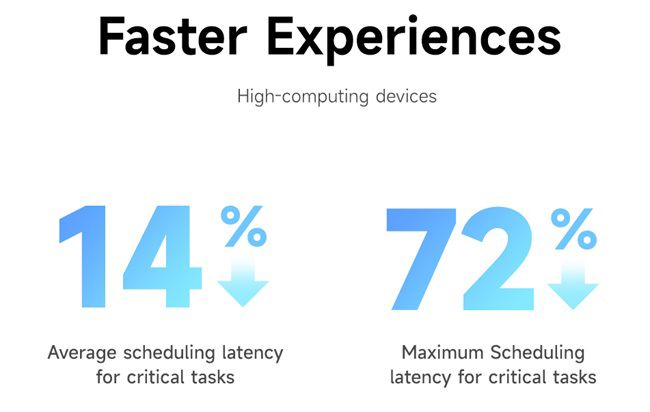
HyperOS introduces several innovative features:
* Xiaomi Smart Hub: Integrates independent devices, providing real-time status updates and active control.
* Xiaomi HyperMind: Proactively understands user requirements and facilitates collaboration between surrounding devices based on usage habits.
* End-to-End security: Implements mutual security checks and hardware-level encryption for reliability and privacy protection.
* One Smart ecosystem: Connects daily devices seamlessly, creating an intelligent mobile space centered around users.
* Consumer IoT platform: Utilizes the world’s largest consumer IoT platform to connect all devices, fostering human-centric innovation.
1. Alive Design Philosophy
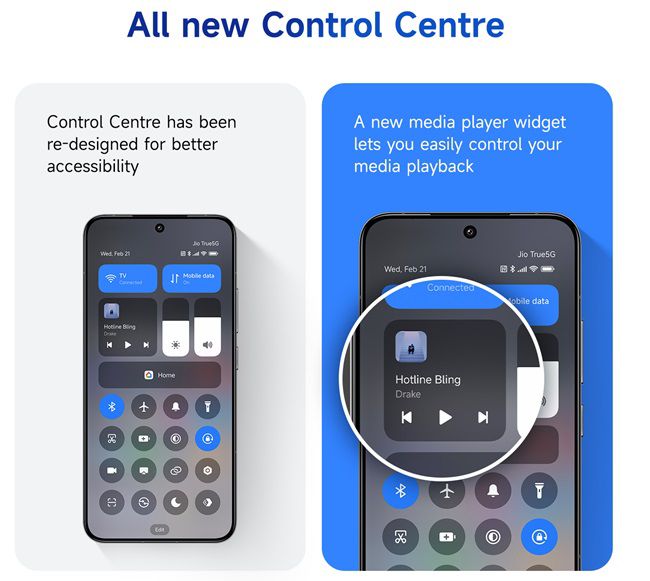
From all-new lockscreens to redesigned icons and a Vitality Color System drawing inspiration from vibrant life colors, Xiaomi HyperOS brings significant enhancement to the phone’s visual appeal.
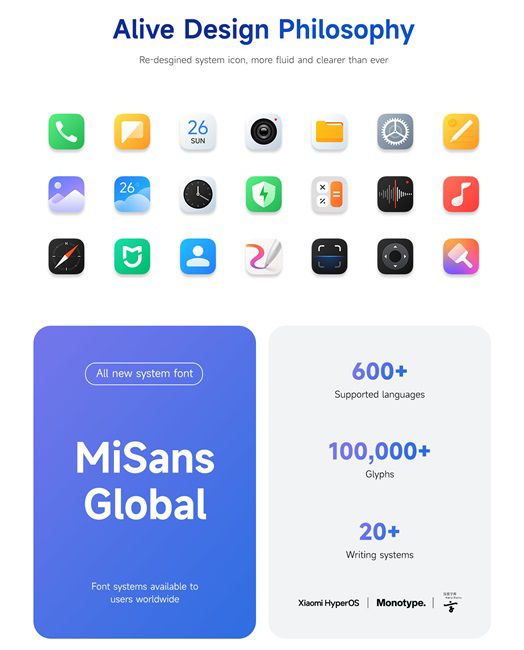
The new UI font – Mi Sans, is supported across 600 languages, 20 writing systems, and over 100,000 glyphs, ensuring a visually captivating and functionally stable experience.
2. Redesigned icons and attention to detail
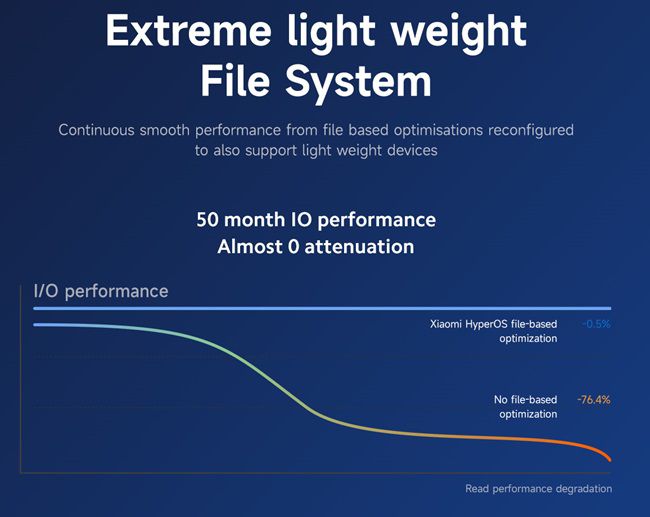
With an all-new lock screen with multiple personalization options, users can choose between Classic, Rhombus, and Magazine effects, each offering thousands of combinations, or add depth with options to customize wallpapers, font text, date, and time style.
System Apps has also been redesigned with softer, textured interfaces, making them easy on the eye and adding character.
3. Xiaomi’s HyperConnect
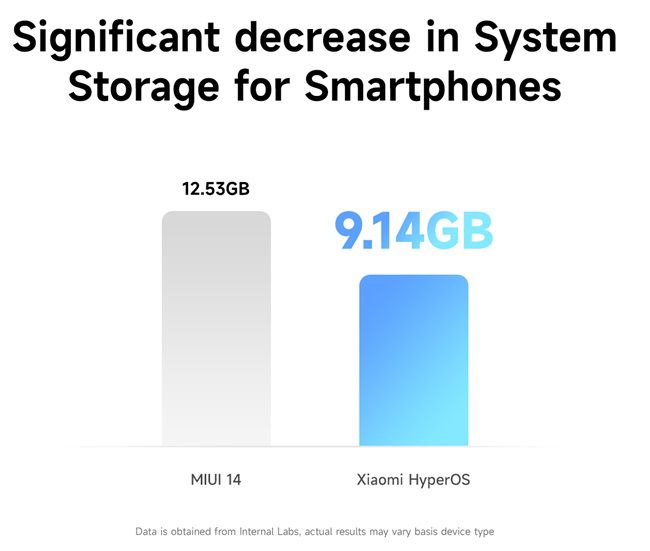
Xiaomi’s HyperConnect introduces groundbreaking features that promise to transform collaboration and productivity across devices.
Among the standout features are HomeScreen+, offering direct screen mirroring for a more immersive experience, and shared Clipboard, streamlining cross-device copying and pasting.
The integration of the phone camera with the Notes app and the introduction of Productivity Mode further underscore Xiaomi’s commitment to redefining the way users collaborate and boost productivity.
With the Xiaomi Smart Hub, up to 7 devices can collaborate simultaneously, including earphones, tablets, smart lights, speakers and much more.
4. Gallery AI
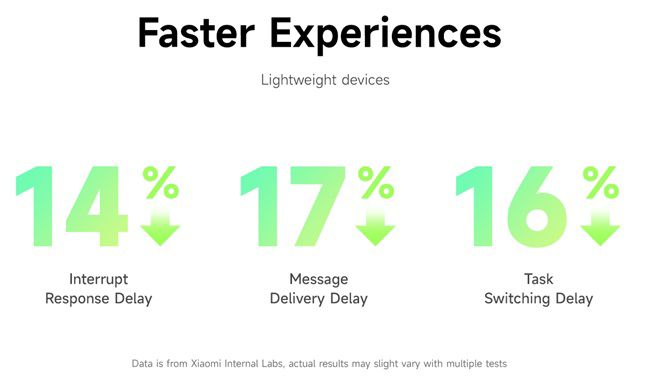
The advanced AI features in Xiaomi’s Gallery app, ensure fast and efficient photo editing while prioritizing user privacy.
From AI Removal to AI Portrait and Generative AI Part, Xiaomi’s Gallery app empowers users to unleash their creativity.
Gallery AI will be rolled out on select Xiaomi devices soon.
Xiaomi HyperOS roll-out roadmap
| Released | March 2024 | Q2, 2024 |
| Xiaomi 13 ProXiaomi Pad 6
Redmi 12 5G Redmi 12C Redmi 11 Prime Redmi Pad |
Xiaomi 12 Pro
Redmi Note 13 Pro + Redmi Note 13 Redmi Note 12 Pro + Redmi Note 12 Pro Redmi Note 12 |
Xiaomi 11 UltraXiaomi 11T Pro
Mi 11X Xiaomi 11i HyperCharge Xiaomi 11 Lite Xiaomi 11i Mi 10 Xiaomi Pad 5
Redmi 13C Series Redmi 12 Redmi Note 11 Series Redmi 11 Prime 5G Redmi K50i |
FAQs
Which Xiaomi devices are eligible for the HyperOS update in India?
Xiaomi has announced that over 26 devices, including the Xiaomi 13 Pro, Xiaomi Pad 6, Xiaomi 11 Ultra, and even the Mi 10, will receive the HyperOS update in India.
What new features does HyperOS bring to Xiaomi devices?
HyperOS offers several new features such as a customisable lock screen, advanced AI functionalities within the gallery app, and a more efficient operating system that requires less storage space.
Will the HyperOS update be based on Android 14 for all devices?
It’s currently unclear if the HyperOS update for older Xiaomi smartphones will be based on Android 14, as is the case with newer devices like the Xiaomi 13 Pro and Xiaomi Pad 6.
When will the HyperOS update be available for Xiaomi devices?
The HyperOS update is expected to roll out to eligible Xiaomi devices, including the Redmi Note 13 series and Xiaomi 12 Pro, in the second quarter of 2024.
What can we expect from the upcoming Xiaomi 14 launching with HyperOS?
The Xiaomi 14 is set to feature the Snapdragon 8 Gen 3 processor, a Leica camera, and will come pre-installed with HyperOS, promising top-notch performance and innovative software enhancements.
What is HyperOS and why is it significant for Indian users?
HyperOS is Xiaomi’s latest operating system, designed to create a seamlessly interconnected ecosystem across a variety of devices.
Its launch in India signifies a major advancement in how users interact with technology, offering enhanced performance, security, and user-centric AI features.
Which devices are compatible with HyperOS?
HyperOS is compatible with an extensive range of devices, including the Xiaomi 14 series, Xiaomi Pad 6S Pro, and wearables like Xiaomi Smart Band 8 Pro, ensuring a wide spectrum of Xiaomi users can enjoy its benefits.
How does HyperOS enhance device performance and efficiency?
HyperOS boosts device performance through its sophisticated resource management system, dynamic thread priority adjustment, and energy-efficient operations, ensuring optimal performance across devices with different RAM capacities.
Can HyperOS improve the security of my devices?
Yes, HyperOS incorporates a self-developed Trusted Execution Environment (TEE) security model, offering robust end-to-end encryption and enhanced privacy features to protect user data across interconnected devices.
What makes HyperOS different from other operating systems?
HyperOS stands out with its integrated device center for easy management of connected devices, AI-powered HyperMind for intuitive user interactions, and its ability to deliver a unified experience across smartphones, smart homes, and automobiles.
What is Performance of HyperOS?
HyperOS boasts remarkable performance enhancements. It leverages Open Source Xiaomi Vela to enrich user experience.
With a 14% reduction in response delay, 17% in message delivery delay, and 16% in task switching, the system ensures peak performance while optimizing power usage, powered by Apache 2.0.
The system also offers accurate load evaluation, analyzing thread relationships comprehensively for precise CPU load assessments.
It delivers faster experiences with up to a 14% reduction in average scheduling latency for critical tasks and a 72% reduction in maximum scheduling latency for such tasks.
Furthermore, lightweight devices experience a 14% reduction in Interrupt response delay, 17% in message delivery delay, and 16% in task switching delay, as per Xiaomi Internal Labs.
HyperOS significantly reduces system storage requirements for smartphones compared to MIUI 14, offering 9.14GB as opposed to 12.35GB.
Additionally, it ensures smooth I/O performance with almost zero attenuation, providing 50-month IO performance.
The system improves OTA storage and performance, reducing OTA occupancy by 79% and OTA time by 24%.
What are Interconnectivity features of HyperOS?
HyperOS facilitates seamless device connectivity through various features:
* Home screen+: Enables effortless drag-and-drop between phone & tablet.
* Shared clipboard: Allows for easy copy-paste across devices.
* Notes app: Permits capturing photos on mobile and inserting them directly into Xiaomi tablets’ notes.
What is Personalization of HyperOS ?
HyperOS prioritizes personalization with its Alive Design Philosophy. It presents a redesigned lock screen with multiple personalization options.
The Control Centre is revamped for better accessibility, accompanied by a new media player widget, re-designed system icons, and diverse UI experiences.
The system font, MiSans, supports over 600 languages, 20 writing systems, and 100,000+ Glyphs.
The upgraded Floating Window allows for viewing multiple apps simultaneously, with a new Workstation mode for enhanced productivity on tablets. Additionally, the Weather app has also been redesigned.
Also Read: Xiaomi HyperOS To Launch in India on 29th Feb: What You Need to Know
Also Read: Xiaomi Confirms HyperOS Roll-out in India; Xiaomi 13 Pro and Pad 6 to be the First Devices To Get it
Also Read: HyperOS Update: Xiaomi Picks 9 Devices For Rollout in Early 2024
